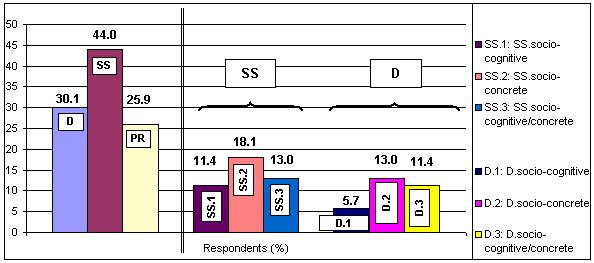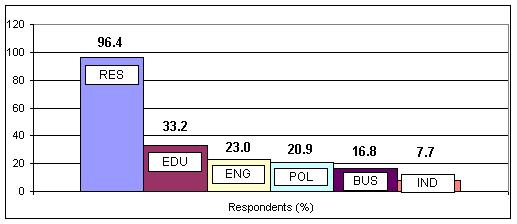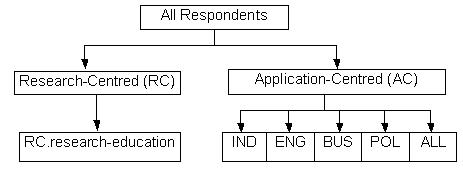Nuno David, Maria Bruno Marietto, Jaime Simão Sichman and Helder Coelho (2004)
The Structure and Logic of Interdisciplinary Research in Agent-Based Social Simulation
Journal of Artificial Societies and Social Simulation
vol. 7, no. 3
<https://www.jasss.org/7/3/4.html>
To cite articles published in the Journal of Artificial Societies and Social Simulation, reference the above information and include paragraph numbers if necessary
Received: 28-Dec-2003 Accepted: 09-May-2004 Published: 30-Jun-2004
 Abstract
Abstract
| |
||||
| Table 1: Number of completed questionnaires. CQ is the number of questionnaires that have been completed (more than 90% answered questions), PQ the number of questionnaires that have been partially completed (between 60% and 90%), R is the number of refusals (respondents who declined to fill in the questionnaire), and NC is the number of non-contacts (if eligible respondents could not be reached with the given email) | ||||
| |
||||
|
Sample Size |
CQ |
PQ |
R |
NC |
|
unknown |
196 |
0 |
22 |
45 |
|
|
||||
|
|
||||
| Table 2: Number of respondents per region (according to the respondents institution affiliation) | ||||
|
|
||||
|
|
Asia & Oceania |
Central and South America |
Europe & Russia |
Canada & USA |
|
Respondents |
17 |
9 |
116 |
54 |
|
|
||||

|
| Figure 1: Percentage of positive responses in each category of the variable "type of model", relative to the total number of respondents |
|
|
|
branch SS (85) –
Researchers with a social-scientific approach
|
Figure 2: Hierarchical organisation of respondents according to the categories of the variable "type of model". Only 193 respondents were considered because three respondents did not choose any available option |

|
| Figure 3: Distribution of respondents according to all branches and leaves of Figure 2 |

|
| Figure 4: Percentage of positive responses in each category of the variable "domain of interest" |

|
|
branch RC (101) Research-Centred |
|
Figure 5: Hierarchical structure and number of respondents according to the categories of the variable "domain of interest" |
|
|
|
Figure 6: Distribution of respondents according to all branches and leaves of Figure 5 |
|
|
||
|
Table 3: The group of sixteen requirements that were selected as "Imperative" or "Important" by more than fifty percent of all respondents. Acronyms A, T, DO and DE stand respectively for membership of Analysis, Technological, Domain and Development facilities |
||
|
|
||
|
Requirement |
Facility |
% |
|
Observe Behavioural Events |
A |
83.2 |
|
Manage Communication |
T |
81.1 |
|
Control Tracking |
A |
75.5 |
|
Define Scenarios |
A |
72.4 |
|
Manage Agents Life Cycle |
T |
71.4 |
|
Manage Scheduling Techniques |
T |
70.4 |
|
Provide Graphical Interface |
A |
69.9 |
|
Model Scalability |
T |
65.8 |
|
Observe Cognitive Events |
A |
64.8 |
|
Provide Graphical Representation of Domain(s) |
DO |
61.2 |
|
Provide Sensitivity Analysis |
A |
59.7 |
|
Develop Agent Architectures |
DE |
57.7 |
|
Use Groups |
DE |
56.6 |
|
Use Roles |
DE |
53.6 |
|
Launch Agents |
DO |
51.0 |
|
Provide Data Analysis |
A |
50.5 |
|
|
||
|
|
|
Figure 7: The number of facilities in Table 3 relative to the total number of requirements available in each set of facilities |
|
|
||
|
Table 4: The sixteen requirements selected as "Desirable" by more than thirty percent of all respondents. Acronyms A, T, DO, DE and E stand respectively for membership of Analysis, Technological, Domain, Development and Exploration facilities |
||
|
|
||
|
Requirement |
Facility |
% |
|
Intervene in Behavioural Events |
E |
43.4 |
|
Intervene in Cognitive Events |
E |
40.8 |
|
Model the Platform Execution Model |
DO |
39.8 |
|
Provide Models of Cognitive Reflectivity |
E |
39.3 |
|
Manage Social Opacity |
E |
38.8 |
|
Manage Intentional Failures |
DO |
37.8 |
|
Use Ontologies |
DE |
36.7 |
|
Provide Translation Mechanisms |
DE |
35.7 |
|
Provide Data Analysis |
A |
33.2 |
|
Develop Agent Architectures |
DE |
32.7 |
|
Use Multiple Societies |
DE |
32.7 |
|
Integrate Controlled and Non-Controlled Environments |
DO |
31.6 |
|
Use Organisational Abstractions |
DE |
31.6 |
|
Adopt Ontological Commitment |
DE |
31.6 |
|
Manage Security |
T |
31.1 |
|
Launch Agents |
DO |
30.6 |
|
|
||
|
|
|
|
Application-Centred Domains |
|
|
|
|
|
|
|
|
Figure 8: Distribution of branches SS, D and PR relative to each domain |
|
|
|
||
| Table 5: Percentages of research-centred and application-centred domains relative to social-scientific, dual and prototyping for resolution branches | ||
|
|
||
|
|
Research-centred |
Application-centred |
|
Branch SS (%) |
63.4 |
36.6 |
|
Branch D (%) |
37.9 |
62.1 |
|
Branch PR (%) |
46.0 |
54.0 |
|
|
||
|
|
|||
|
Table 6: The use of socio-cognitive and socio-concrete models within the dual branch, relative to the total number of respondents in domains policy, engineering and research-centred |
|||
|
|
|||
|
|
D.socio-cognitive |
D.socio-concrete |
D.cognitive/concrete |
|
Research-centred (%) |
7.2 |
6.2 |
9.3 |
|
Policy (%) |
0.0 |
22.7 |
9.1 |
|
Engineering (%) |
11.1 |
14.8 |
11.1 |
|
|
|||
|
|
|||||
|
Table 7: Requirements selected as Imperative or Important in branches social-scientific, dual and prototyping for resolution |
|||||
|
|
|||||
|
branch SS |
% |
branch D |
% |
branch PR |
% |
|
Manage Communication |
81.7 |
Manage Communication |
81.0 |
Observe Behavioral Events |
86.0 |
|
Manage Scheduling Techniques |
81.7 |
Observe Behavioral Events |
81.0 |
Manage Communication |
82.0 |
|
Observe Behavioral Events |
81.7 |
Manage Agents Life Cycle |
74.1 |
Control Tracking |
78.0 |
|
Control Tracking |
80.5 |
Define Scenarios |
74.1 |
Manage Agents Life Cycle |
68.0 |
|
Provide Graphical Interface |
78.0 |
Manage Scheduling Techniques |
72.4 |
Define Scenarios |
66.0 |
|
Manage Agents Life Cycle |
73.2 |
Use Groups |
67.2 |
Guarantee Independency from the Simulator |
64.0 |
|
Define Scenarios |
73.2 |
Control Tracking |
63.8 |
Observe Cognitive Events |
64.0 |
|
Model Scalability |
72.0 |
Provide Graphical Interface |
63.8 |
Model Scalability |
62.0 |
|
Provide Graphical Representation of Domain(s) |
68.3 |
Model Scalability |
60.3 |
Launch Agents |
62.0 |
|
Observe Cognitive Events |
68.3 |
Provide Sensitivity Analysis |
60.3 |
Provide Graphical Interface |
62.0 |
|
Provide Sensitivity Analysis |
68.3 |
Provide Graphical Representation of Domain(s) |
58.6 |
Use Roles |
54.0 |
|
Develop Agent Architecture |
61.0 |
Develop Agent Architecture |
58.6 |
Manage Scheduling Techniques |
52.0 |
|
Provide Data Analysis |
58.5 |
Use Roles |
58.6 |
Model the Platform Execution Model |
52.0 |
|
Use Groups |
53.7 |
Observe Cognitive Events |
56.9 |
Develop Agent Architecture |
52.0 |
|
Use Organisational Abstractions |
50.0 |
Launch Agents |
53.4 |
Provide Graphical Representation of Domain(s) |
50.0 |
|
Use Roles |
50.0 |
Intervene in Behavioural Events |
48.3 |
Integrate Controlled and Non-Controlled Environments |
48.0 |
|
|
|||||
|
Use Organisational Rules |
50.0 |
Use Organisational Abstractions |
46.6 |
Use Groups |
48.0 |
|
Launch Agents |
41.5 |
Use Organisational Rules |
46.6 |
Use Ontologies |
48.0 |
|
Intervene in Behavioural Events |
41.5 |
Provide Data Analysis |
46.6 |
Provide Sensitivity Analysis |
46.0 |
|
Intervene in Cognitive Events |
41.5 |
Intervene in Cognitive Events |
44.8 |
Adopt Ontological Commitment |
44.0 |
|
Integrate Controlled and Non-Controlled Environments |
39.0 |
Guarantee Independence from the Simulator |
43.1 |
Use Organisational Abstractions |
42.0 |
|
Manage Intentional Failures |
35.4 |
Integrate Controlled and Non-Controlled Environments |
41.4 |
Provide Data Analysis |
42.0 |
|
|
|||||
|
|
||||
|
Table 8: Requirements that reveal differences of approximately fifteen percent between any two branches |
||||
|
|
||||
|
|
branch SS (%) |
branch D (%) |
branch PR (%) |
P-value |
|
SS Inclined |
||||
|
Manage Scheduling Techniques |
81.7 |
72.4 |
52.0 |
P=0.001 |
|
Provide Graphical Representation of Domains |
65.9 |
58.6 |
50.0 |
- |
|
Provide Sensitivity Analysis |
68.3 |
60.3 |
46.0 |
P=0.040 |
|
Control Tracking |
46.5 |
26.1 |
27.5 |
- |
|
PR Inclined |
||||
|
Guarantee the Independency from the Simulator |
32.9 |
43.1 |
64.0 |
P=0.002 |
|
Launch Agents |
40.0 |
53.4 |
62.0 |
- |
|
Model the Platform Execution Mode |
26.8 |
29.3 |
52.0 |
P=0.008 |
|
Use Ontologies |
26.8 |
34.5 |
48.0 |
P=0.046 |
|
Adopt Ontological Commitment |
23.2 |
27.6 |
44.0 |
P=0.036 |
|
Manage Security |
12.2 |
25.9 |
32.0 |
P=0.017 |
|
|
||||
|
|
|
Figure 9: A classification of paradigmatic models in Agent-Based Social Simulation |
|
|
|
|
Table 9: Classification of models versus the patterns of responses in Figure 3 |
|
|
|
|
|
Classification of models |
Pattern of Responses |
|
socio-technical |
D branch |
|
socio-analytic |
SS branch, including or not artificial social models |
|
techno-analytic |
PR branch, including or not artificial social models |
|
prototyping for resolution |
PR branch without artificial social models |
|
social-scientific |
SS branch without artificial social models |
|
socio-cognitive |
SS.socio-cognitive leaf without artificial social models |
|
socio-concrete |
SS.socio-concrete, leaf without artificial social models |
|
|
|
|
|
|
Figure 10: Characterisation of artificial social models |
|
|
|
Figure 11: Characterisation of socio-cognitive models |
|
|
|
Figure 12: Characterisation of socio-concrete models |
|
|
|
Figure 13: Characterisation of social-scientific models |
|
|
|
Figure 14: Characterisation of socio-analytic models |
|
|
|
Figure 15: Characterisation of prototyping for resolution models |
|
|
|
Figure 16: Characterisation of techno-analytic models |
|
|
|
Figure 17: Characterisation of socio-technical models |
2 simsoc(simsoc@jiscmail.ac.uk), cormas(cormas@cines.fr), swarm‑modelling(swarm‑modelling@santafe.edu), distributed-AI (distributed-ai@jiscmail.ac.uk) and agents (agents@cs.umbc.edu).
3 The domain "Industry" is omitted since its number of respondents is negligible.
4 The term would-be world is borrowed from Casti 2001, but the meaning that he ascribes to the term is slightly different form ours.
5 This does not mean that the dimensions are (orthogonally) independent of each other, as we will demonstrate later.
AXELROD R. (1997) "The Dissemination of Culture: A Model with Local Convergence and Global Polarization". The Complexity of Cooperation Agent-Based Models of Competition and Collaboration , Princeton University Press, pp.148-177.
BARRETEAU O., BOUSQUET F. and ATTONATY J. (2001) Role-Playing Games for Opening the Black Box of Multi-Agent Systems: Method and Lessons of its Application to Senegal River Valley Irrigated Systems. Journal of Artificial Societies and Social Simulation, Vol. 4, n.2, https://www.jasss.org/4/2/5.html.
CALDAS J.C., COELHO H. (1999) "The Origin of Institutions: Socio-Economic Processes, Choice, Norms and Conventions". Journal of Artificial Societies and Social Simulation, Vol. 2, n.2, https://www.jasss.org/2/2/1.html.
CASTELFRANCHI C., CONTE R. and PAOLUCCI M. (1998) "Normative Reputation and the Costs of Compliance". Journal of Artificial Societies and Social Simulation, Vol.1, n.3, https://www.jasss.org/1/3/3.html.
CASTI J. (2001) "Would-Be Business Worlds",. Complexity, Vol. 6, n.2, John Willey & Sons, pp.13-15.
CONTE R., CASTELFRANCHI C. (1995) Cognitive and Social Action, UCL Press.
CONTE R., DIGNUM F. (2001) "From Social Monitoring to Normative Influence". Journal of Artificial Societies and Social Simulation, Vol. 4, n.2, https://www.jasss.org/4/2/7.html
CONTE R., SICHMAN J.S. (1995) "DEPNET: How to benefit from social dependence". Journal of Mathematical Sociology, Vol.20, pp. 161-177.
CONTE R., EDMONDS B., MOSS S. and SAWYER K. (2001) "Sociology and Social Theory in Agent Based Social Simulation: A Symposium". Computational and Mathematical Organization Theory, Vol.7, n.3, pp.183-205.
CONTE R., GILBERT N. and SICHMAN J.S. (1998) "MAS and Social Simulation: A Suitable Commitment". Proc. of the 1st. International Workshop on Multi-Agent Systems and Agent-Based Simulation, Lecture Notes in Artificial Intelligence, Springer-Verlag, Vol. 1534, pp.1-9.
DAVIDSSON P., BOMAN M. (2000) "Saving Energy and Providing Value Added Services in Intelligent Building: A MAS Approach". Mobile Agents and Applications, Springer-Verlag, pp.166-177.
DEAN J. S., GUMERMAN G.J., EPSTEIN J.M., AXTELL R., SWEDLAND A.C., PARKER M.T. and MCCARPOEL S. (1999) "Undertanding Anasaki Culture Change Through Agent-Based. Modeling Small Scale Societies. New York: Oxford University Press.
DECKER K. (1996) "Distributed Artificial Intelligence. Foundations of Distributed Artificial Intelligence, New York: John Willey & Sons, pp.119-138.
EDMONDS B. (2000) "The Use of Models Making MABS more Informative". Second International Workshop on Multi-Agent-Based Simulation, Boston, USA, Lecture Notes in Artificial Intelligence, Springer-Verlag, Vol. 1979, pp.15-31.
EL HADOUAJ S., DROGOUL A. and ESPIä S. (2000) "How to Combine Reactivity and Anticipation: The Case of Conflicts Resolution in a Simulated Road Traffic". Lecture Notes in Artificial Intelligence, Springer-Verlag, Vol. 1979, pp. 82-96.
EPSTEIN J. and AXTELL R. (1996) Growing Artificial Societies: Social Science from the Bottom up, MIT. Press.
FOWLER F.J. (1984) Survey Research Methods. Thousand Oaks: CA, Sage.
GOLDSPINK C. (2000) "Modelling Social Systems as Complex: Towards a Social Simulation Meta-Model".. Journal of Artificial Societies and Social Simulation, Vol.3, n.2, https://www.jasss.org/3/2/1.html.
GROSS D. and STRAND R. (2000) "Can Agent-Based Models Assist Decisions on Large-Scale Practical Problems? A Philosophical Analysis". Complexity, Vol.5, n.6, pp. 26-33.
LAIRD J. E., NEWELL A. and ROSENBLOOM P. (1987): "Soar: An Architecture for General Intelligence". Artificial Intelligence, Vol.33, pp.1-64.
LOVELOCK J. (1992) "A Numerical Model for Biodiversity". Philosophical Transactions of the Royal Society of London, Vol. 338, pp 383-391.
MARIETTO M. B., DAVID N., SICHMAN J.S.and COELHO H. (2002) "Requirements Analysis and Agent-Based Simulation Platforms: State of the Art and New Prospects". Proc. of the Third International Workshop on Multi-Agent-Based Simulation, Lecture Notes in Artificial Intelligence, Berlin: Springer-Verlag, Vol. 2581, pp.89-104.
MARIETTO M. B., DAVID N., SICHMAN J.S.and COELHO H. (2003) "A Classification of Paradigmatic Models for Agent-Based Social Simulation", Proc. 4th. International Workshop on Multi-Agent Based Simulation (MABS'03), Melbourne, Australia.
MULLER H.J., MALSCH T. and SCHULZ-SCHAEFFER I. (1998) "SOCIONICS: Introduction and Potential", Journal of Artificial Societies and Social Simulation, Vol.1, n.3, http://www.soc.survey.ac.uk/JASSS/1/3/5.html.
ROBOCUP (2003) RoboCup, http://www.robocup.org/.
SCHELLING T.S. (1971) "Dynamic Models of Segregation". Journal of Mathematical Sociology, Vol.1, n.2, pp.143-186.
SIMCOG (2003) Simulation of Cognitive Agents, http://www.lti.pcs.usp.br/SimCog/.
STALLER A. and PETTA, P. (2001) "Introducing Emotions into the Computational Study of Social Norms: A First Evaluation". Journal of Artificial Societies and Social Simulation, Vol. 4, n.1, https://www.jasss.org/4/1/2.html.
TROITZSCH K. (1997) "Social science simulation - origins, prospects, purposes". Lecture Notes in Economics and Mathematical Systems, Berlin: Springer-Verlag, Vol. 456.
Return to Contents of this issue
© Copyright Journal of Artificial Societies and Social Simulation, [2004]